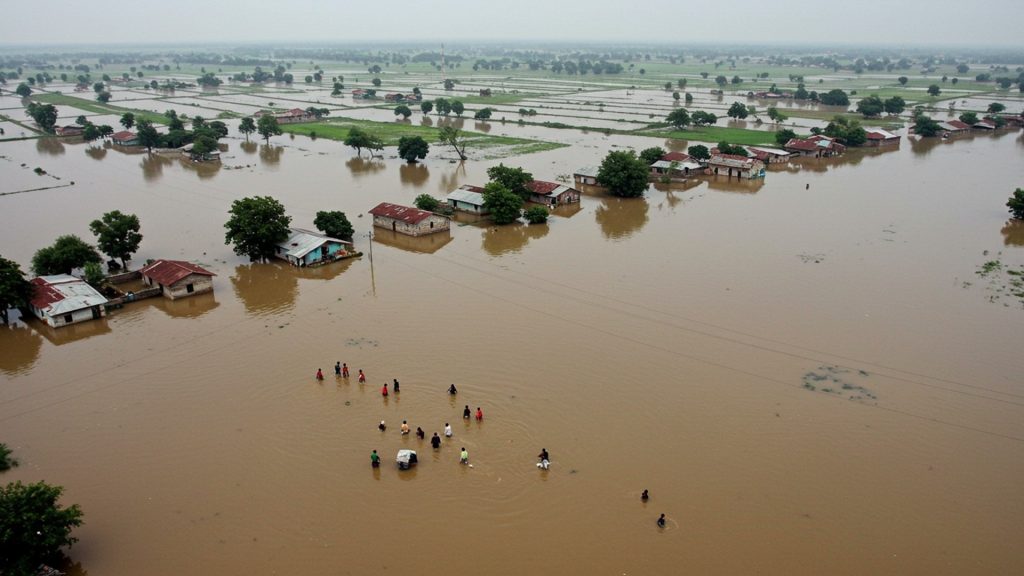Heavy monsoon rains continue to lash Bihar, plunging vast areas into severe flooding and widespread waterlogging. Daily life for millions is grinding to a halt as homes are submerged, roads become impassable. essential services face severe disruption across the state. This relentless deluge, intensifying over the past 48 hours, has triggered an urgent crisis, forcing thousands to seek higher ground and overwhelming local authorities as they struggle to manage the rising waters and provide aid. The situation remains critical with no immediate relief in sight, as the monsoon’s grip tightens, leaving a trail of destruction and hardship.
Heavy Rains Cause Widespread Flooding
Bihar is currently facing a severe flood situation as continuous heavy rainfall has led to rising water levels in major rivers across the state. More than 25 lakh (2. 5 million) people have been affected across at least ten districts, with several new areas coming under the grip of floods.
The worst-hit districts include Bhagalpur, Begusarai, Munger, Bhojpur, Patna. Vaishali. Other significantly impacted areas are Lakhisarai, Supaul, Buxar, Khagaria, Saran. Katihar. In Bhagalpur district alone, over 6. 5 lakh people have been impacted by the floodwaters.
The main rivers, including the Ganga, Gandak, Kosi, Bagmati, Mahananda, Sone, Punpun, Burhi Gandak, Ghaghara, Falgu. Dardha, are all flowing above danger levels. This surge is largely due to constant heavy rainfall in their catchment areas, especially in neighboring Nepal. For instance, the Ganga river has turned very strong, with its water levels rising from Buxar to Kahalgaon in Bhagalpur district. All 108 gates of the Farakka Barrage have been opened because the river crossed the danger mark. In Patna, the Ganga river’s water level was recorded at 43 centimeters above the Farakka level and 20 centimeters above the danger mark. Satellite images show that about 15 percent of Patna district is under water. Bhagalpur has 15. 7 percent of its land flooded.
Impact on Daily Life and Local Areas
The widespread flooding and waterlogging have severely disrupted daily life for millions of people across Bihar. Many urban areas, including the capital city Patna, are experiencing significant waterlogging. Key routes in Patna such as Bailey Road, Ashok Rajpath. Kankarbagh have seen slow-moving traffic. Localities like Rajendra Nagar, Kankarbagh, Patel Nagar, Patliputra Colony, Rajeev Nagar, Digha. areas near Patliputra Junction and Danapur are particularly affected, with streets still underwater despite efforts to pump out water. Residents describe the situation as difficult, with senior citizens and sick people finding it hard to move through flooded lanes.
Beyond urban centers, rural areas are also deeply impacted. Villages have been submerged. in some places like Bhojpur’s Jawaniya village, over 50 homes have been washed away. Roads have submerged, making travel difficult. In Khagaria, students are reportedly using boats to reach school, showing how basic activities are now major challenges. A large number of people who have lost their homes are forced to live in temporary shelters, on high ground, or along highways.
The monsoon’s intensity has not only affected transportation but also caused soil erosion in several villages along the Ganga River banks in Bhagalpur. This ongoing problem can damage land and homes further.
Challenges for Farmers and Crops
The floods have brought significant losses to the agriculture sector, which is a key part of Bihar’s economy. Farmers are facing crop damage due to the sudden inundation of their fields. An unexpected flood earlier in the year, in January 2025, caused by a rise in the Genhua River in Darbhanga district, destroyed hundreds of acres of standing Rabi crops, including wheat, maize, lentils. vegetables. This was a shock to farmers who were already dealing with cold weather. Farmers have reported devastating losses, with some lamenting that their crops were destroyed after they had borrowed money for them. The State Agriculture Minister had previously stated that floods severely damaged up to 150,000 hectares of crops in September 2024. Officials from the Agriculture and Disaster Management Departments have been instructed to assess the current crop losses suffered by farmers and ensure they receive payment for the damage.
Government Actions and Relief Operations
The Bihar government has quickly started relief and rescue operations to help affected communities. Chief Minister Nitish Kumar has held several high-level meetings to review the flood situation and direct officials. He also conducted an aerial survey of the flood-affected districts, including parts of Patna, Vaishali, Begusarai. Munger, to comprehend the ground reality.
During these meetings, the Chief Minister gave clear instructions:
- Provide shelter and cooked meals to affected people through community kitchens. Over 1. 3 million people have already been served food at these centers.
- Arrange fodder and veterinary care for livestock.
- Deploy disaster response teams immediately. Currently, 16 teams of the National Disaster Response Force (NDRF) and State Disaster Response Force (SDRF) have been deployed. These teams, supported by over 60 motorboats and 1,233 smaller boats, are actively engaged in rescue operations, evacuating stranded residents and shifting them to safer places. Over 32,800 people have been safely moved with the help of these boats.
- Distribute essential relief materials. More than 52,500 polythene sheets and 1,800 dry ration packets have been distributed.
- Ensure quick financial aid. Chief Minister Kumar announced a direct cash transfer of ₹7,000 for every flood-affected family in Bhagalpur. He also directed officials to make sure that a ‘gratuitous relief’ amount is quickly given to flood-affected residents.
- Assess and repair damaged infrastructure, especially roads, to ensure people can move freely and access help.
The Chief Minister has stressed the importance of remaining alert along riverbanks, where water levels continue to rise. He urged all officials to act swiftly and with care. Various government departments, including Water Resources, Agriculture, Road Construction, Disaster Management, Health. Rural Development, are working together to manage both immediate and long-term needs.
Steps for the Future
Bihar frequently faces floods during the monsoon season. In anticipation of the 2025 monsoon, the state government had approved a large plan worth ₹562 crore for 173 anti-flood projects. A significant part of this plan, about ₹86 crore, was to be spent outside India, across the Nepal border, because many rivers that cause floods in Bihar start in the Himalayas and flow through Nepal. These projects aim to tackle erosion at the source to reduce the impact of floods when they reach Bihar. The government is also looking into better water management plans, including improved coordination with Nepal on releasing water from upstream dams. There is also a focus on using early warning systems and advanced weather forecasting to prepare communities in advance for floods. The government plans to review current flood control policies and bring in necessary changes.
As the monsoon continues, the India Meteorological Department has issued yellow and orange alerts for heavy rainfall in many districts, warning of thunderstorms and lightning in the coming days. This points to the situation could remain challenging. Despite the ongoing disruption, the recent rainfall has been a relief for farmers in some areas as the state had been experiencing a rainfall deficit earlier in the season. No deaths have been reported in any district due to the current floods.

